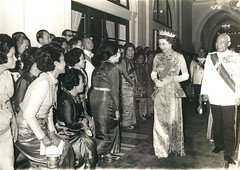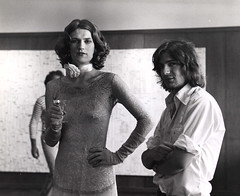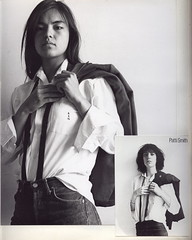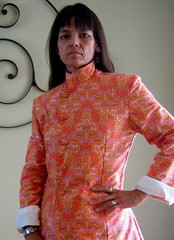Dressing the Eco-Feminist, Ethnic, Lesbian
The day I saw the shelves of organic cotton clothing at Country Sun health food store, I said aloud to no one in particular, thus startling another shopper, "So it's come to this, has it?"
Assessing the shapeless designs with their muted earth tone hues, I felt as though we had arrived at the door of George Orwell's 1984. "No way", I thought to myself. I would never be able to embrace these drab colors of a puritanical eco-sensibility. I was, after all, from the land of Thai silk, whose vivid hues had stunned the editor of Vogue magazine, back in the '50s when the silk was presented to her by an American named Jim Thompson.
The world needs more Americans like Jim Thompson, for he was the consummate lover of all that was beautiful and beautifully created, but not yet "discovered". Like the budding naturalist in an unruly gang of boys, he was the one who stopped and said no let's not kill it, look at how beautiful it is. At the time that he found Thai silk, it was only being woven by a few weavers for formal wear in the royal court. But rather than gathering up these weavers and putting them in a factory to produce under his boss man authority, he encouraged the cottage industry and gave the women shares in his Thai Silk Company. He also standardized the wooden looms and introduced the colorfast jewel tone dyes that so characterize modern Thai silk. (And no, I don't know if the dyes are toxic.) Only later would Thai businesswomen set up said factories to meet the production demands of the market he essentially created.
I visited one with my grandmother in the early '80s. Her old school friend owned such a factory not far from our house. The friend greeted us in the air-conditioned showroom, with its floor to ceiling teak shelves, full of the folded cloth arranged like oversize books. Each piece was a slight shade advanced from its neighbor thus creating a chromatic sequence that made a rainbow look institutional.
After I had chosen an aqua marine turquoise double weight silk for a suit I would have made by a local seamstress, the proprietor opened the door to the factory floor. There in a brightly lit white room, vented to the outside with louvered windows near the ceiling, were rows of women seated at traditional wooden looms. They were dressed in cotton sarongs and moved rhythmically, the sounds of wood on wood creating a pleasant accompaniment to the scene.
The high price of Thai silk reflected this handmade care. Thus it was with a certain reverence that my family spoke of the silk. It was associated with the best tailors and the most high holy occasions. And my, were those occasions splendid with entire ballrooms filled with such outfitted ladies, no two alike.
With that kind of upbringing woven deep into my psyche, it was no wonder that I balked at the drab offerings of the environmentally conscience clothing options I found at my local health food store, not to mention the hemp dominated Green Festival.
It was only a matter of time before I would have to reconcile my love of textiles with my eco principles. Environmental, social justice activists are not supposed to care about clothes. We are urged to protest sweatshop labor, denounce the impact of pesticide ridden, nitrate polluting cotton farming, decry fashion as the capitalist engine driving consumerism (which it is) and wear clothes that look like we've owned them for all of our adult lives.
On a day-to-day basis, I do adhere to these principles, filling my closet with khakis and travel shirts (made overseas most likely by cheap labor working long ours). Sweatshop jobs may be an improvement over even longer hours, and no pay, working for a family patriarch on the farm, but there was still the energy and water used in textile and clothing production to factor in, as well as fuel expenditure of the ocean going freighters and the portside air pollution in Los Angeles as trucks idled while loading.
My daily uniform, however, was so generic I discovered I could find the pants and shirts, used at thrift stores, in the preppie parts of town, thus lowering my eco footprint. (Given the 68 pounds of clothes that Americans donate per person per year, there is enough used clothing to bale and ship back overseas to keep most of the African continent, Eastern Europe, the former Soviet Union and parts of South Asia and South America stylishly dressed.)
There were, however, events to attend, parties and such. I first learned to dress for parties from my drag queen friend, Mark, whom I met at college. All the closets in his house had been expanded to hold double rows of vintage women's clothes, size 11 shoes and wigs. His dresser drawers were filled with gloves, purses and other treasured accessories. Throughout the school year he would display his outfits at each event, two at a time, changing midway through the evening.
This being UC Santa Cruz in the late '70s, the rest of us were a motley crew of shaggy hair in boot cut jeans, dykes in overalls and straight girls in long skirts and peasant blouses. To distinguish myself from the peasant blouse contingent, as well as the overalls, I dressed up my jeans with a red thrift store blazer, which I pretended was my prep school uniform in envy of my mother's British girls' school heritage. (I did go to a girls' prep school, but it did not outfit us with natty blazers).
What captured my imagination about my drag queen friend was that he managed to evoke a power and vulnerability that was riveting on his six-foot frame. He transcended overt objections to his gender bending, bisexuality by becoming a performance artist. I wanted this power for myself.
The first vintage dress I bought was a chic black sheath number in moiré satin, with drop shoulders circumscribed by erect geometric petals revealing the breasts encased in pale pink of the same fabric. I bought it for Mark. Before I could give it to him, a party was scheduled and I decided to dress for him instead. With my family's sewing machine (my mother was an avid home sewer and my father made his own pants), I took the dress in about three inches up the back seam and made it fit. Donning a bright red pair of stiletto sandals, the only pair I owned, I made my entrance into the dorm lounge where the party was being given. Mark, in a vintage dress, per usual, got on his knees at my feet and looked up at me admiringly, then wished upon me a nice big cock. Heh! I was accepted in the club. I was a drag queen!
To continue to generate that hands-off (but only when I want it) power that Mark had perfected, I bought a motorcycle, on my return to the Bay Area, and outfitted myself in a classic black leather jacket and black leather pants tailored for me by a German craftsman in San Francisco, Tauber Leathers. Black steel-toe boots completed my armor.
Under the leathers, I was fond of Western wear until I lived with a lover who owned horses. One day we were on a riding trip with friends in Brazil. The only man in the party (American and white) had on his blue jeans, a t-shirt and a straw hat. I think he may have even been chewing on a grass stalk. Watching him from a distance, he so cut the figure of a lone cowboy, that I was overcome with a curious, burning jealousy of both his gender and race. No matter how stylin' my Tony Lama boots, or how perfectly shaped my hat, I would never achieve that level of authenticity. Out went the cowboy shirts.
Inspired by my karate gi/uniform when I took up martial arts, I designed a Tibetan style vest from black gabardine to wear over my white pirate shirts (from Deva, an American company employing local home sewers). I had been investing in Folkwear patterns, a company that reproduced instructions for the making of traditional clothing from around the world as opposed to the ever-changing styles put forth by high fashion designers. Indigenous clothes were simple and adaptable. I had made the African pants repeatedly in printed cottons for summer wear.
To better tailor the African pants pattern to go with the vest, I put in a pleat from my hipbone to my ankle, then buttoned up the pleat down the shin with loops, not buttonholes. The overall effect of this "pantsuit" was more modern than ethnic, business like, but not corporate and masculine without identifiable male detailing.
An acquaintance was so taken by it, she begged me to make the same outfit for her. I considered charging her a lofty fee to cover my time. It would have looked great on her, too, but this "look" was so authentically me, I had to let it be uniquely mine for a while longer, so I turned down her request. The suit still stands me in good stead, today, as an alternative to the business suit.
To let loose my flamboyant Thai silk roots, I later sewed the Tibetan Panel Coat in a vivid green and gold sarong patterned silk that my grandmother had given to me. Worn with a bright yellow Ukraine shirt with trim of the same silk, it was a fabulous outfit that united me with everything I loved about the Thai sense of design. Okay, so I could really only wear it at Christmas parties.
Back to every day fashions. Was it true that lesbians were chic now? I tested the premise by picking a conservative function to wear one of my dad's narrow ties, pulled away from the neck, on a white shirt with black jeans. It was my high school reunion and my classmates were wearing floral print garden party dresses. I couldn't have looked more out of place, but I was not shunned, only welcomed with animated interest. The only person who avoided any contact with me was a teacher, clearly a butch lesbian, probably closeted.
What other looks were butch? What about the Utilikilt? Men who wore these black skirts with the cargo pockets, looked tough, but disarmingly gender bending. Would I look butch in one, or more like a Japanese schoolgirl? I didn't want to spend the $140 to order one to find out. Maybe I could make one. My search for a kilt pattern took me into the land of Renaissance Fairs and pirate costumes. Hmm, yes, my English roots. What if I made men's shirts, both historical and modern, using the highly vivid Asian prints in my collection of textiles?
The first shirt I made was an ordinary short sleeve camp shirt from a bright plaid Indian cotton that a client had given me. It took me a week to make what would probably take a factory fifteen minutes, but I loved it and wore it with great care, pairing it with a black bolero jacket from a vintage dress and my Thai hill tribe pants, to come up with a whole new outfit that still had an ethnic sensibility.
As I matched my box of salvaged fabrics with my collection of patterns, I visualized seven designs — an entire Fall Collection! It included a Chinese hip length vest cut from a red dressing gown with white piping, a Peter Max coat in a pink and yellow '60s print, a sea green vintage Chinese cheongsam dress re-cut into a sleeveless doublet, a ruffled poet's shirt of green cotton and a Renaissance style bicycle jacket made from army surplus snow camo backpack covers—white for better night time visibility. I had my work cut out for me.
The second shirt took even longer as I redesigned the pattern halfway through to include more interesting pleating details that mimicked a slashed doublet with full sleeves, also pleated. Catherine was impressed when I was done, said it looked Renaissance with an Asian twist, given the block printed dark pink fabric I had chosen. Yes, it was presentable and had a stylish look that was not exactly current, but wasn't not current either; it made me think of the '60s. I was enjoying myself.
"You know," I said to Catherine who recently joined the Slow Food movement and had made her first homemade pizza, "I think I've just invented the Slow Clothes movement."
Pithy facts provided by the book "The Travels of a T-Shirt In The Global Economy" by Pietra Rivoli. An intellignet exploration by an economist professor seeking to answer the social jutice issues raised by student activists regarding sweatshop produced clothing. She does not, however, mention environmental impact as a factor of industtry. Thus the need for more activists to raise these issues.
Labels: environment, fashion, globalization, sustainability







